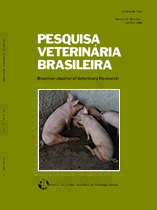 |
|
|
|
Year 2017 - Volume 37, Number 9
|

|
Prevalence and risk factors for porcine cysticercosis in rural communities of eastern Minas Gerais, Brazil, 37(9):905-910
|
ABSTRACT.- Acevedo-Nieto E.C., Pinto P.S.A., Silva L.F., Guimarães-Peixoto R.P.M., Santos T.O., Ducas C.T.S. & Bevilacqua P.D. 2017. Prevalence and risk factors for porcine cysticercosis in rural communities of eastern Minas Gerais, Brazil. Pesquisa Veterinária Brasileira 37(9):905-910. Setor de Medicina Veterinária Preventiva, Departamento de Veterinária, Universidade Federal de Viçosa, Avenida PH Rolfs s/n. Viçosa, MG 36570-900, Brazil. E-mail: ecanieto@gmail.com
Cysticercosis is caused by Taenia solium, a parasitic zoonosis that affects human and pigs raised free-range in developing countries. The epidemiology of the taeniosis cysticercosis complex in Brazil is poorly understood especially when it comes to field research. The aim of this study was to estimate the prevalence and identify the risk factors associated with porcine cysticercosis in rural communities located in the east of Minas Gerais (MG), Brazil. From 371 farms in the county of Tumiritinga/MG, 101 farms from 14 communities were randomly sampled. Blood samples from pigs were collected, and epidemiological questionnaires were carried out. The serum samples obtained were analyzed through immunodiagnosis techniques, including ELISA and Western Blot, both for the detection of antibodies. The data obtained by different surveys were analyzed using EpiInfo 3.5.1 software to determine seroprevalence and risk factors associated with cysticercosis. The prevalence of farms with porcine cysticercosis was 9.9% (10/101) and antibody-based seropositive was 5.3% (13/247). The results indicate that cysticercosis occurs in high level in the rural area never studied before. These results suggest the presence of tapeworm carriers contributing to the occurrence and maintenance of this zoonotic life cycle in the county. Regarding risk factors, the most significant determinants for porcine cysticercosis in the field were free-range pig management (OR: 17.4, p: 0.0001), the method of disposal of human faeces in the environmental (OR: 7.6; p 0.012), and the size of the farm. Porcine cysticercosis was diagnosed only in areas represented by Agrarian Reform Settlements. From the results, it is possible to recommend as a means of control and prevention the destination of human faeces in appropriate sanitary landfills and the production of pigs in an enclosed area. Additionally, improving education in the communities sampled will indirectly affect the spreading of this disease. The results draw attention to the largest studies of this zoonotic disease in human settlements from rural areas due to the lack of knowledge about the epidemiology of the taeniosis-cysticercosis complex. The results could serve as the basis to support public policies aimed at creating an effective program to control the taeniosis-cysticercosis complex in the studied area. Awareness of TC among medical doctors, veterinarians, meat animal family producers and the public should be developed through appropriate information and education |
| |
|
|
| |
|
 |